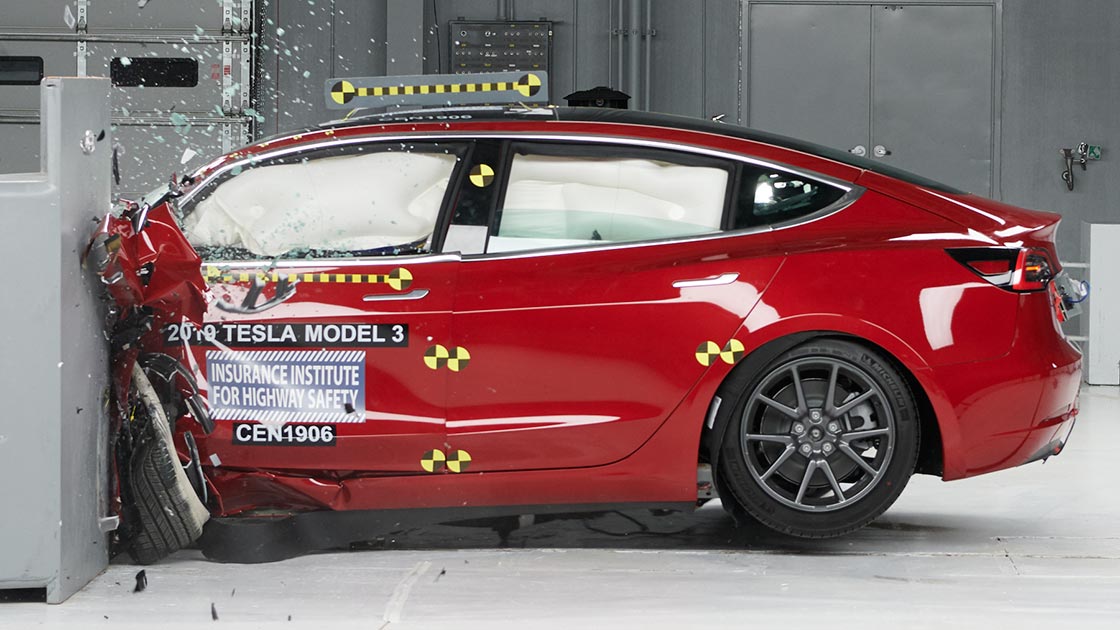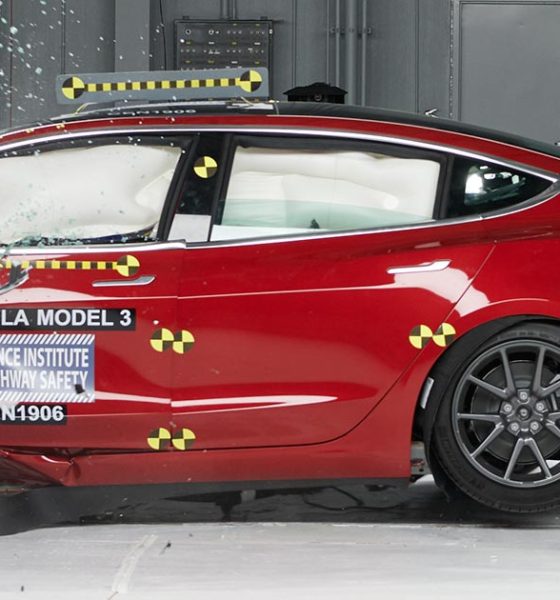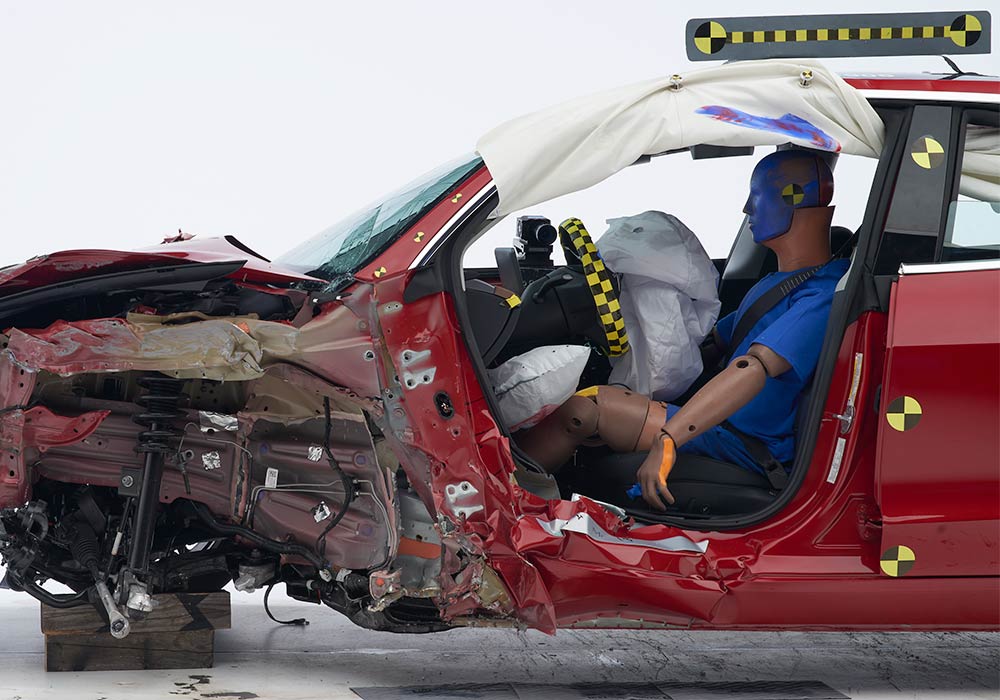

News
Tesla Model 3 receives Top Safety Pick+ award from the IIHS
The Insurance Institute for Highway Safety (IIHS) has released the results of its crash tests for the Tesla Model 3, and just like other safety agencies in the US and abroad, the organization has granted the all-electric sedan its highest rating available. In a recent announcement, the IIHS has revealed that the Tesla Model 3 qualifies for its Top Safety Pick+ award.
The IIHS notes that to earn the Top Safety Pick+ award, a vehicle must get good ratings in the driver-side small overlap front, moderate overlap front, side, roof strength, and head restraint tests. Good ratings are also required in the passenger-side small overlap test and the headlight evaluation, the latter proving to be a tricky metric that is rarely aced by carmakers.
The Model 3 earned good ratings across the board for crashworthiness, with the vehicle’s front crash prevention system getting a superior rating after successfully avoiding collisions in both the 12 mph and 25 mph track tests. The Model 3’s strong frame also allowed the vehicle to perform well in challenging tests such as the driver-side small overlap front test. Additionally, the Model 3’s headlights received a good rating for being bright enough without causing glare to other drivers.

With its results, the Tesla Model 3 joins the all-electric Audi e-tron and the hydrogen-powered Hyundai Nexo as the IIHS’ Top Safety Pick+ vehicles for 2019. Speaking about these results, IIHS Chief Research Officer David Zuby remarked that the stellar safety performance of these vehicles proves that cars with alternative powertrains do not compromise in terms of safety. “Vehicles with alternative powertrains have come into their own. There’s no need to trade away safety for a lower carbon footprint when choosing a vehicle,” he said.
In a blog post, Tesla explained that the Model 3’s Top Safety Pick+ rating from the IIHS is due to the vehicle’s all-electric structural and powertrain design, which gives the car a low center of gravity that reduces rollover risk while protecting occupants in the event of a crash. Of course, the absence of an engine results in a generous crumple zone in front of the Model 3, which absorbs energy more effectively during a collision. The Model 3’s glass roof also proved very strong, resisting more than 20,000 pounds of force.
Apart from receiving the IIHS’ Top Safety Pick+ rating, the Tesla Model 3 has also earned a 5-Star Safety Rating from the National Highway Traffic Safety Administration (NHTSA). The all-electric sedan also set new benchmarks in safety at its tests with the European New Car Assessment Program (Euro NCAP), as well as the Australasian New Car Assessment Program (ANCAP).
Watch the IIHS’s featurette on the Tesla Model 3’s stellar safety results in the video below.
Read Tesla’s blog post about the IIHS’ Top Safety Pick+ award for the Model 3 below.
Model 3 Earns the 2019 IIHS TOP SAFETY PICK+ Award
We engineer our cars to be the best in the world – in every category. Model 3, our most affordable car yet, is no exception. From the start, we designed it to be among the safest cars ever built, with the goal of getting as many Model 3s on the road as possible to further our mission.
Model 3 has already earned a 5-star safety rating in every category and sub-category from safety authorities on three continents (North America, Europe and Australia), and it has received top marks around the world for its advanced safety assistance features like Automatic Emergency Braking.
Now, in new tests from the Insurance Institute for Highway Safety (IIHS), Model 3 has been named a 2019 IIHS TOP SAFETY PICK+ vehicle, the highest achievement awarded by the Institute. To evaluate whether Model 3 met the criteria for this top rating, IIHS tested the car’s crashworthiness, occupant protection, crash avoidance, and headlight systems. Model 3 earned top marks in all eight tests, including a superior rating in front crash prevention, which evaluates a car’s Automatic Emergency Braking system, and the highest possible rating in IIHS’ headlight assessment.
Here’s a look at some of the ways we made this happen:
Part of what makes Model 3 so safe is its all-electric powertrain design, which gives the car a low center of gravity that reduces roll-over risk, as well as its rigid aluminum and steel passenger cabin that provides exceptional strength to equally protect drivers and passengers. Additionally, Model 3’s lack of an engine is replaced by a large crumple zone that helps it absorb energy more effectively than a gas car would, dissipating force away from the passenger cabin. This crumple zone contributed to Model 3’s top rating in IIHS’ frontal crash protection tests.
The Institute’s results also demonstrate the exceptional strength of Model 3’s all-glass roof, which is supported by a very strong metal body structure and helps protect occupants in roll-over crashes. During testing, the car’s roof was able to successfully resist more than 20,000 pounds of force – that’s more than if we placed five Model 3s on top of the car’s roof at once. And, the roof earned a higher strength-to-weight ratio score than any other fully electric vehicle that IIHS has ever tested.
In addition, Model 3’s safety restraint system also earned high marks in IIHS’ evaluation. This was due in part to Model 3’s seats, which are designed and manufactured in-house at our dedicated seat factory in Fremont, as well as our thick curtain airbag and uniquely shaped front passenger airbag, which help protect a passenger’s head from the car’s A-pillar and center screen.
In terms of crash mitigation, good headlights can help prevent nighttime crashes, which is why Model 3 comes standard with automatic high and low beam headlights that earned top marks in IIHS testing. And, when it comes to crash prevention, Model 3 earned a superior rating thanks to our Automatic Emergency Braking system, which successfully avoided collisions at both 12 miles per hour and 25 miles per hour.
The safety of our customers is what matters most, which is why our active safety features and passive safety equipment come standard on all of our cars. We’re also committed to making our cars even safer over time via over-the-air updates, helping us ensure that all Tesla drivers have access to the best safety features available for their cars.

Elon Musk
Tesla’s Elon Musk gives timeframe for FSD’s release in UAE
Provided that Musk’s timeframe proves accurate, FSD would be able to start saturating the Middle East, starting with the UAE, next year.

Tesla CEO Elon Musk stated on Monday that Full Self-Driving (Supervised) could launch in the United Arab Emirates (UAE) as soon as January 2026.
Provided that Musk’s timeframe proves accurate, FSD would be able to start saturating the Middle East, starting with the UAE, next year.
Musk’s estimate
In a post on X, UAE-based political analyst Ahmed Sharif Al Amiri asked Musk when FSD would arrive in the country, quoting an earlier post where the CEO encouraged users to try out FSD for themselves. Musk responded directly to the analyst’s inquiry.
“Hopefully, next month,” Musk wrote. The exchange attracted a lot of attention, with numerous X users sharing their excitement at the idea of FSD being brought to a new country. FSD (Supervised), after all, would likely allow hands-off highway driving, urban navigation, and parking under driver oversight in traffic-heavy cities such as Dubai and Abu Dhabi.
Musk’s comments about FSD’s arrival in the UAE were posted following his visit to the Middle Eastern country. Over the weekend, images were shared online of Musk meeting with UAE Defense Minister, Deputy Prime Minister, and Dubai Crown Prince HH Sheikh Hamdan bin Mohammed. Musk also posted a supportive message about the country, posting “UAE rocks!” on X.
FSD recognition
FSD has been getting quite a lot of support from foreign media outlets. FSD (Supervised) earned high marks from Germany’s largest car magazine, Auto Bild, during a test in Berlin’s challenging urban environment. The demonstration highlighted the system’s ability to handle dense traffic, construction sites, pedestrian crossings, and narrow streets with smooth, confident decision-making.
Journalist Robin Hornig was particularly struck by FSD’s superior perception and tireless attention, stating: “Tesla FSD Supervised sees more than I do. It doesn’t get distracted and never gets tired. I like to think I’m a good driver, but I can’t match this system’s all-around vision. It’s at its best when both work together: my experience and the Tesla’s constant attention.” Only one intervention was needed when the system misread a route, showcasing its maturity while relying on vision-only sensors and over-the-air learning.
News
Tesla quietly flexes FSD’s reliability amid Waymo blackout in San Francisco
“Tesla Robotaxis were unaffected by the SF power outage,” Musk wrote in his post.

Tesla highlighted its Full Self-Driving (Supervised) system’s robustness this week by sharing dashcam footage of a vehicle in FSD navigating pitch-black San Francisco streets during the city’s widespread power outage.
While Waymo’s robotaxis stalled and caused traffic jams, Tesla’s vision-only approach kept operating seamlessly without remote intervention. Elon Musk amplified the clip, highlighting the contrast between the two systems.
Tesla FSD handles total darkness
The @Tesla_AI account posted a video from a Model Y operating on FSD during San Francisco’s blackout. As could be seen in the video, streetlights, traffic signals, and surrounding illumination were completely out, but the vehicle drove confidently and cautiously, just like a proficient human driver.
Musk reposted the clip, adding context to reports of Waymo vehicles struggling in the same conditions. “Tesla Robotaxis were unaffected by the SF power outage,” Musk wrote in his post.
Musk and the Tesla AI team’s posts highlight the idea that FSD operates a lot like any experienced human driver. Since the system does not rely on a variety of sensors and a complicated symphony of factors, vehicles could technically navigate challenging circumstances as they emerge. This definitely seemed to be the case in San Francisco.
Waymo’s blackout struggles
Waymo faced scrutiny after multiple self-driving Jaguar I-PACE taxis stopped functioning during the blackout, blocking lanes, causing traffic jams, and requiring manual retrieval. Videos shared during the power outage showed fleets of Waymo vehicles just stopping in the middle of the road, seemingly confused about what to do when the lights go out.
In a comment, Waymo stated that its vehicles treat nonfunctional signals as four-way stops, but “the sheer scale of the outage led to instances where vehicles remained stationary longer than usual to confirm the state of the affected intersections. This contributed to traffic friction during the height of the congestion.”
A company spokesperson also shared some thoughts about the incidents. “Yesterday’s power outage was a widespread event that caused gridlock across San Francisco, with non-functioning traffic signals and transit disruptions. While the failure of the utility infrastructure was significant, we are committed to ensuring our technology adjusts to traffic flow during such events,” the Waymo spokesperson stated, adding that it is “focused on rapidly integrating the lessons learned from this event, and are committed to earning and maintaining the trust of the communities we serve every day.”
News
Waymo scrutinized after self-driving taxis cause traffic jams during SF blackout
It’s not farfetched to speculate that it would have been a doomsday scenario for Tesla had FSD behaved this way.

A power outage across San Francisco over the weekend forced numerous Waymo self-driving taxis to stop at darkened intersections and cause traffic blockages in multiple locations across the city. The disruption left riders stranded, frustrated drivers blocked, and city officials stepping in as the Alphabet-owned company temporarily suspended service amid the widespread gridlock.
Needless to say, it would likely have been a doomsday scenario for Tesla had FSD behaved in a similar way, especially if fleets of its robotaxis blocked traffic for numerous drivers.
Power outage halts Waymo fleet
The outage knocked out electricity for tens of thousands of customers, leaving traffic signals dark across large parts of the city, as noted in a report from the New York Times. Waymo vehicles began stopping at intersections and remained stationary for extended periods, seemingly unable to operate. Tow truck operators worked through the night removing immobilized vehicles, while videos circulated online showing Waymos with hazard lights flashing as traffic backed up around them.
Waymo later confirmed that it had paused its Bay Area ride-hailing service after the San Francisco mayor’s office contacted the company about the congestion its vehicles were contributing to. Service began coming back online shortly after 3:30 p.m. local time, though some users still reported being unable to request rides. Waymo maintained that no injuries or accidents were reported during the outage.
Autonomous cars during emergencies
The incident surprised industry observers since autonomous vehicles are designed to function during signal outages and temporary connectivity losses. Waymo stated that its vehicles treat nonfunctional signals as four-way stops, but “the sheer scale of the outage led to instances where vehicles remained stationary longer than usual to confirm the state of the affected intersections. This contributed to traffic friction during the height of the congestion.” Experts suggested the problem may have been linked to the vehicles’ reliance on remote assistance teams, which help resolve complex situations the cars cannot handle independently.
“Yesterday’s power outage was a widespread event that caused gridlock across San Francisco, with non-functioning traffic signals and transit disruptions. While the failure of the utility infrastructure was significant, we are committed to ensuring our technology adjusts to traffic flow during such events,” the Waymo spokesperson stated, adding that it is “focused on rapidly integrating the lessons learned from this event, and are committed to earning and maintaining the trust of the communities we serve every day.”








